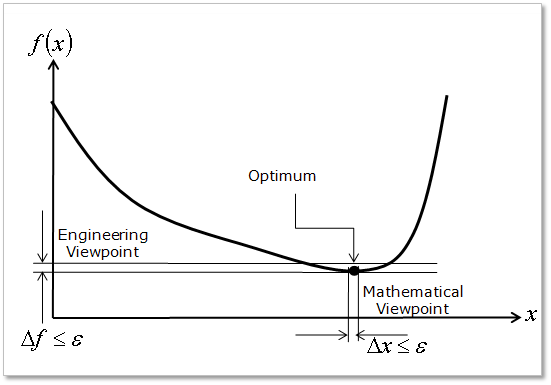21.3.4.1. Convergence Criteria
AutoDesign is a Sequential Approximate Optimizer, which uses meta-models. Thus, its convergence criteria are checked by using only the function values. The followings are four conditions:
The objective changes between consecutive iterations should be less than the user- defined tolerance. The default value is 0.05.
\(|\frac{f_k-f_{k-1}}{f_k}| \leq Tole(1)\)
Thus, the unconstrained optimization process can be pre-maturely terminated from the mathematical optimization viewpoint. The mathematical convergence criterion however is inefficient from the engineering viewpoint, because it requires much computation near optimum. Figure 21.76 shows the difference between both criteria.

Figure 21.76 Graphical representation of convergence criterion for objective
Note
If you solve an unconstrained optimization problem, it is noted that the final design may not be best. The intermediate design can be best in the optimization history. Empirically, this phenomenon occurs when the performance functions are noisy or discontinuous. Then, the meta-model cannot estimate their real behaviors. Thus, AutoDesign may converge to a local design, even though it starts with the best point in the history. If this phenomenon occurs in your design problem, it is recommended that you check whether the performance indexes include unexpected numerical noise or discontinuity.
If the design problem includes constraints, all constraints such as equality and inequality should be satisfied with their limits and its objective change is still satisfied. Equality constraints are transformed as
\({{h}_{i}}\equiv \left| \frac{f(x)}{Limit}-1 \right|\le Tole(2),i=1,2,...,{{N}_{eq}}\)
and inequality constraints are two types. One is a “less than” type and another is a “greater than” type. Both are transformed as
\({{g}_{i}}\equiv \left\{ \begin{matrix} \left| \frac{f(x)}{Limit}-1 \right| \\ \left| 1-\frac{f(x)}{Limit} \right| \\ \end{matrix} \right\}\le Tole(3),i=1,2,...,{{N}_{ieq}}\)
In order to avoid severe computation, if the objective change is satisfied and all constraints are nearly satisfied with their tolerance, then AutoDesign is completed because the final design is nearly active.
Finally, the user can define the maximum iteration. If the optimization process is not converged within this value, it is recommended to check the violation amount. If the violation is gradually reduced until the maximum iteration is reached, then, you may restart with all the analysis results. When you define the DOE method for meta-model, deactivate “Select DOE Method” and check “Get from simulation history”. Then, check all the simulation results and select all the simulation results. Finally, in the optimization control, perform the new optimization in the same process.
If the design variables cannot change during consecutive iterations even though polynomial types are automatically changed in the meta-model, AutoDesign is stop, because there is no feasible solution or no design improvement. If this phenomenon occurs, first, check the design formulation. If the design formulation is good, then resize the design variable range. It is noted that good formulation is to minimize the numerical noise when the performance indexes are evaluated.